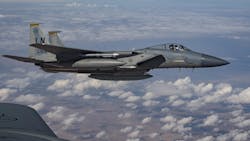Boeing to install upgraded infrared search and track sensors aboard Air Force F-15 jet fighter aircraft
WRIGHT-PATTERSON AFB, Ohio – U.S. Air Force air combat experts are asking electro-optics engineers at the Boeing Co. and Lockheed Martin Corp. to upgrade infrared search and track (IRST) sensors for the Air Force F-15C jet fighter aircraft to enable the aircraft to detect, track, and attack enemy aircraft in a stealthy way without making its presence known.
Officials of the Air Force F-15 Division Contracts Branch at Wright-Patterson Air Force Base, Ohio, announced a $17.8 million order last month to the Boeing Defense, Space & Security segment in St. Louis to upgrade F-15 Infrared Search and Track (IRST) systems to the U.S. Navy Block II configuration.
Boeing will supervise retrofit of the F-15 IRST production versions by replacing the infrared receiver processor of the Air Force Block I Legion Pod with the V3 infrared receiver and V3 processor from the Navy Block II IRST version. The sensors order includes modifying the cabling harness within the pod structure.
The IRST Block II system, which Boeing is buying from the Lockheed Martin Missiles and Fire Control segment in Orlando, Fla., uses infrared search and track technology to detect and provide weapons-quality track solutions on potentially hostile aircraft.
The Navy and Boeing first flew the IRST Block II pod on a Navy F/A-18E/F Super Hornet jet fighter-bomber in late 2019. IRST is a passive, long-range sensor that blends infrared and other sensor technologies for accurate targeting.
The IRST Block II will give the Air Force F-15 jet fighter improved optics and processing power, and significantly improve pilot situational awareness, Boeing officials say. The Block II variant will be delivered to the U.S. Navy this year, reaching initial operational capability shortly thereafter.
The IRST passive search system consists of a passive longwave infrared receiver, a processor, inertial measurement unit, and environmental control unit. The infrared receiver, processor, and inertial measurement unit fit inside the sensor.
The Navy developed the IRST Block I using components from the F-15K/SG aircraft's infrared receiver, which is based on the IRST design of the now-retired Navy F-14 Tomcat jet fighter. IRST Block II includes improvements to the infrared receiver and updated processors.
Even amid electronic attack or heavy RF and infrared countermeasures, IRST provides autonomous, tracking data that increases pilot reaction time, and enhances survivability by enabling first-look, first-shoot capability, Lockheed Martin officials say.
Infrared sensors like the IRST detect the heat from an aircraft's engine exhaust or even the heat generated by the friction of an aircraft as it passes through the atmosphere. Unlike radar, infrared sensors do not emit electronic signals, and do not give away their presence to adversaries.
This ability can enable F-15 pilots to identify enemy aircraft at long ranges, and enable them to fire their air-to-air missiles at their maximum ranges.
Data from the IRST system can stand alone or fuse with the F-15's on-board sensor data. Lockheed Martin also is developing an IRST pod that can be fitted to the Air Force F-16 jet fighter.
On this contract Boeing will do the work in St. Louis, and should be finished by October 2022. For more information contact Boeing Defense, Space & Security online at www.boeing.com/company/about-bds, Lockheed Martin Missiles and Fire Control at www.lockheedmartin.com, or the Air Force F-15 Division Contracts Branch at www.aflcmc.af.mil.
About the Author
John Keller
Editor-in-Chief
John Keller is the Editor-in-Chief, Military & Aerospace Electronics Magazine--provides extensive coverage and analysis of enabling electronics and optoelectronic technologies in military, space and commercial aviation applications. John has been a member of the Military & Aerospace Electronics staff since 1989 and chief editor since 1995.
